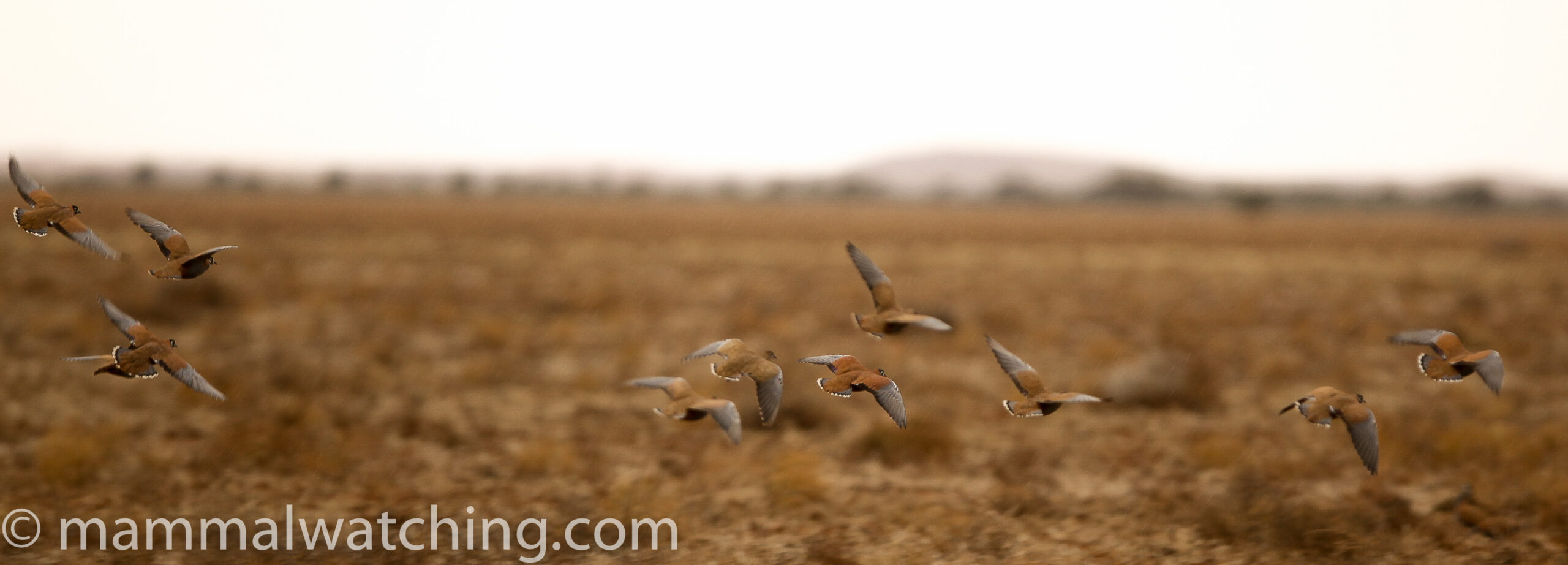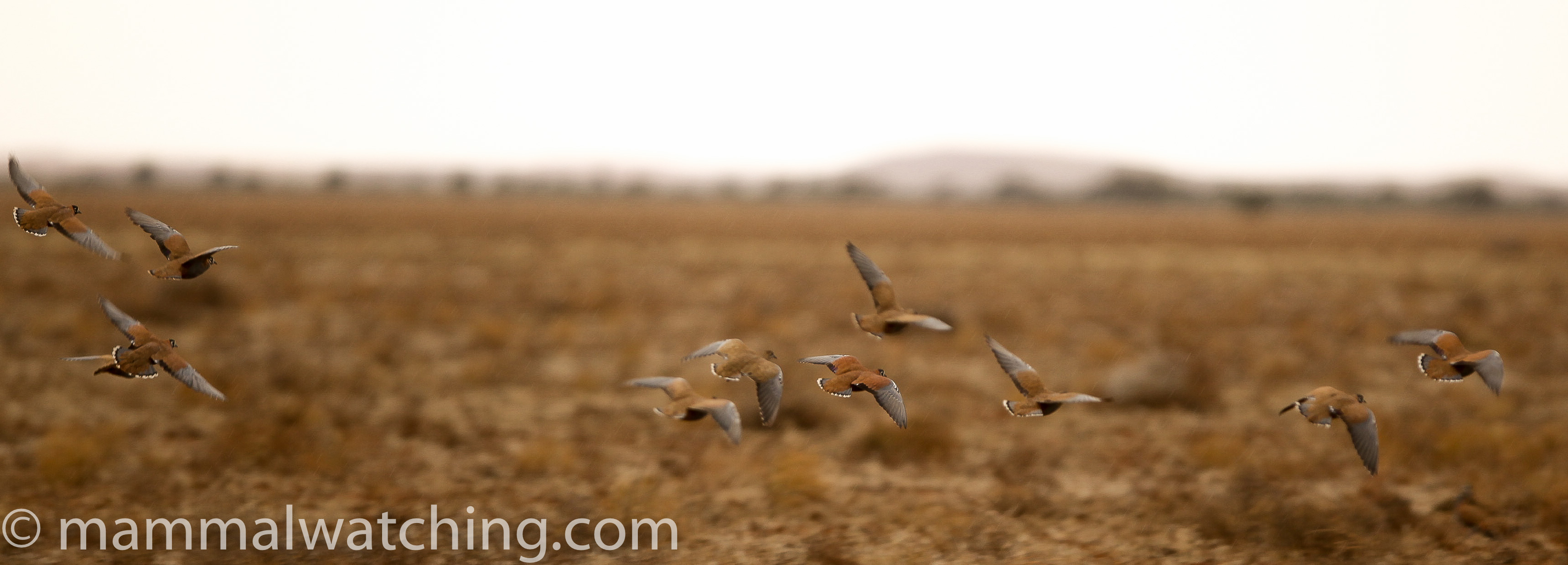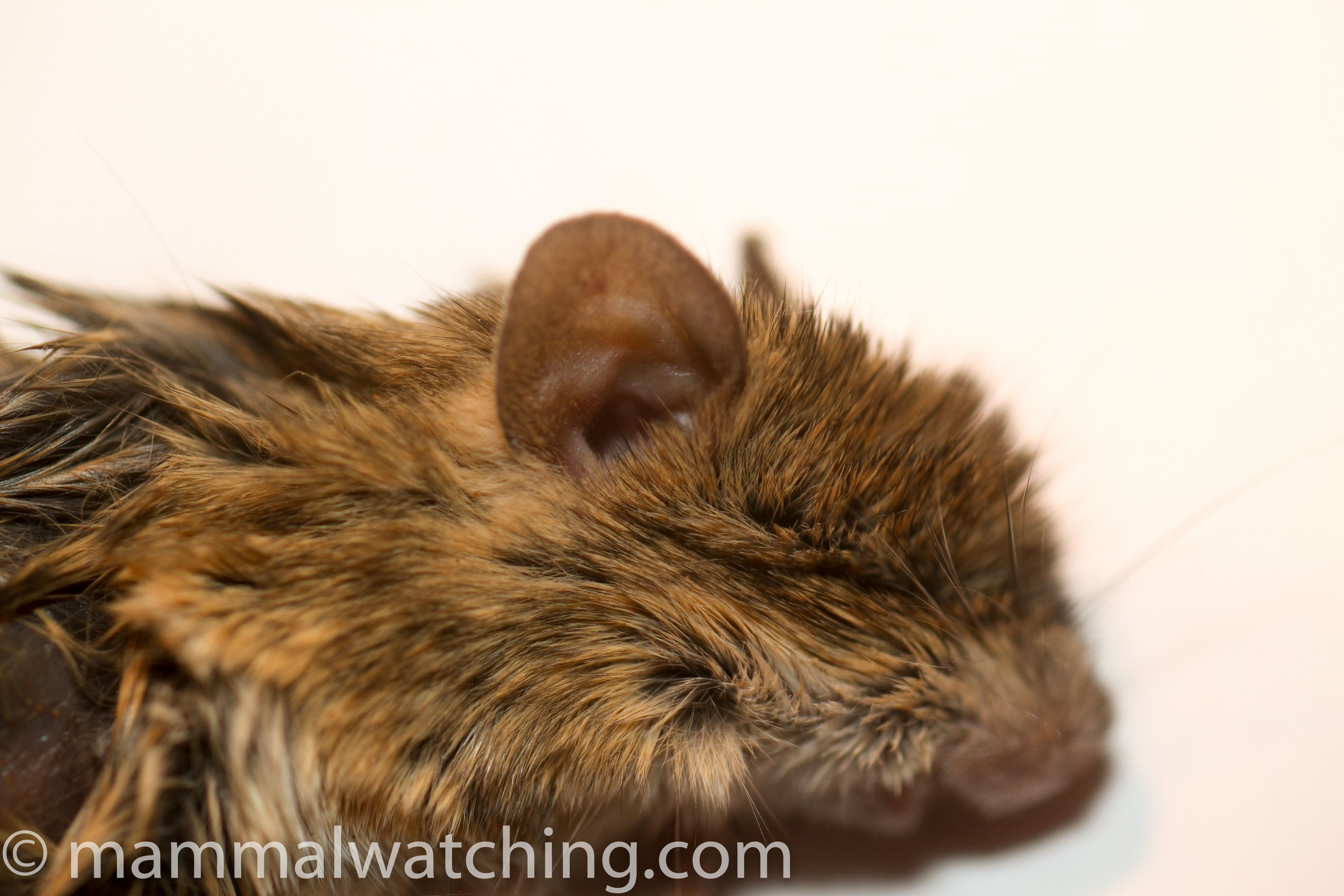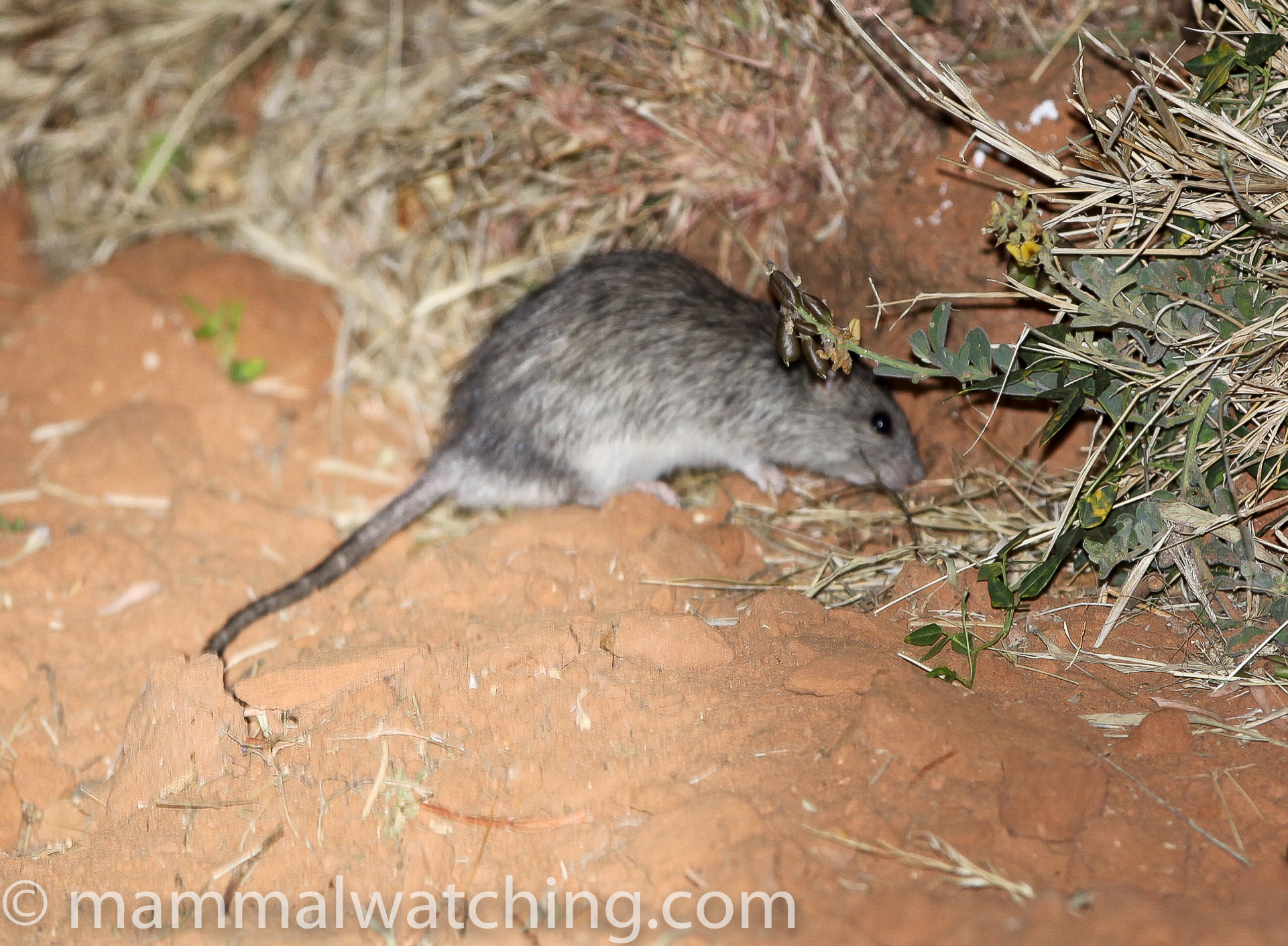
South Australia

Flock Bronzewings, Mt Dare
South Australia (SA) is not among Australia’s finest mammal watching destinations. SA is almost entirely arid, or semi-arid, making mammal watching a challenge and most of the interesting species are hard to find even with traps. It also seems to have suffered more than its fair share of extinctions largely I suppose from land clearance and introduced species. That said, there are some good spots that are well worth visiting, both for the scenery and the mammals. The most notable of which to my mind are Kangaroo Island and the Flinders Ranges.
Adelaide is one of Australia’s friendliest cities. I have not been able to discover a huge amount of mammalian action in or around town, but Water Rats are quite common in the Torrens (the main river through the city). If you visit any of the stretches of river running through quieter areas it is worth walking quietly. I found several rats easily in the middle of the day in September 1999. Western Pygmy Possums are occasionally reported from people’s gardens in some of the satellite towns, such as those in the Adelaide Hills.
Kangaroo Island is just a 30 minute flight on a small airplane from Adelaide, or a 45 minute sail on a biggish ferry from Cape Jervis (a couple of hours drive from Adelaide). It is worth spending at least two days here. The national parks service runs several walking tours each day through the Australian Sealion Colony (this “walking tour” is just a hundred metres or so along the beach by the visitor’s centre but you can get up close and personal with the sealions and it is nicely done). There is also a large colony of New Zealand Fur Seals, which often have a few Australian Fur Seals thrown in for good measure, at Admirals Arch in Flinders Chase National Park. Tammar Wallabies are very common on the island and the island subspecies is endemic. Western Grey Kangaroos are also present in good numbers. Koalas, were introduced to the fox-free island in the 1920s when fears about their extinction on the mainland were growing. They are also very common and damaging the gum trees: easy to see in places like Flinders Chase National Park. Echidnas are everywhere – you are almost bound to see them when you are driving around the island. Brushtail Possums are also abundant.
Harder to find are Western and Little Pygmy Possums (a chance you might run into either species on flowering gums or banksias etc). The Kangaroo Island, or Sooty, Dunnart is endemic and is one of Australia’s least known mammals. It is either very rare or very hard to catch.
The Flinders Ranges are quintessentially Australian, and the snaking backbone of the range running through the desert is the view from top of St Mary’s Peak – one of my favourite anywhere in the world. There are plenty of Red Kangaroos, Western Greys and Wallaroos around. But the key species here is the Yellow Footed Rock-Wallaby, arguably the most attractive macropod in Australia. I saw one of these at dusk in Brachina gorge, while Wilkawillina Gorge is another good spot apparently. There are some quite nice small dasyurids in the park but you’d have to hook up with a fauna survey to have a chance of seeing them come out of the traps.
Brookfield Conservation Park, just outside Blanchetown on the Stuart Highway, east of Adelaide, protects a remnant population of Southern Hairy Nosed Wombats. Their burrows are easy to find, and although the park closes at sunset the Wombats can often been seen sunning themselves in the mid to late afternoon (or at any time in the winter). I found a wombat sitting on top of a burrow, just on dusk. Bona fide mammal watchers can try to arrange access to the park after dark by contacting the volunteer conservation programs. The park also run Brookfield Sunset Tours for bookings of 6 to 10 people. More information on Brookfield can be found here
The Nullabor Plain: I have never been across the Nullabor but in the Austral winter months many Southern Right Whales congregate at the head of the Great Australian Bight. Watching them from the surrounding cliff tops looks pretty speccy from the photos I have seen. Australian Sealions are around too. Southern Hairy Nosed Wombats are common across the Nullabor plain towards and across the Western Australian border.
Renmark and the Bookmark Biosphere Reserve: crossing the border into South Australia from Victoria will often take you through the town of Renmark. Koalas are common here. Renmark is also the jumping off point to visit Calperum Station and the Bookmark Biosphere Reserve (which joins onto Birds Australia’s Gluepot Reserve). This is some of the best looked after mallee country in Australia, with a swag of good birds and mammals. There is extensive fox baiting and as a result the wildlife was doing pretty well in 2001 when I visited to help out with a fauna survey. During 4 days we caught many Common Dunnarts, a few Southern Ningauis, many house mice and eventually one Bolam’s Mouse. I had not seen a Bolam’s mouse before (or since) and I had agonised over many of the House Mice. But the Bolam’s mouse we caught on the last morning was very obviously not a house mouse. A much more roman nose, rounded head and larger ears. The notchless upper incisors were another giveaway. All of these animals were caught in pitfall buckets.
Western Gray Kangaroos and feral goats were common. We caught a couple of Inland Mormopterus bats (the short penis form) during a night’s harp trapping.
Portland (Victoria) is on the southern coast, just over the Victorian border. At Easter each year it is a hotspot for Blue Whales (mainly Pygmy Blues) with the occasional Fin and Sei whale too. See the Australian whale watching page for more information. It would be worth keeping an eye out around the eastern edge of South Australia’s coast line from late March through April.
Naracoorte is north west of Portland, and near Mount Gambier. It is famous for its large cave system that is home to Southern Bentwing Bats, officially a subspecies Miniopterus oceanensis bassanii though a few people seem to think they should be a full species in their own right. There are several tours of the caves each day and the bats can often be seen in Blanche cave, particularly in Winter. They can also be watched via CCTV in the bat observation centre. And of course in the summer they emerge en masse each dusk.
The Desert. I haven’t spent much time in the South Australian desert. Coober Pedy is well worth a look, and when I was there I drove out to the ‘Moon Plains’ near town. I saw very little during an hour’s spotlighting other than a Dingo near the dog fence and a massive feral Cat. But others visiting at around that time saw several Plains Mice (Pseudomys australis) and Kultarrs. In 2011 I crossed into South Australia briefly from the NT and spent the night at Mt Dare, 10 km into South Australia. There were plenty of Plains Mice and Long-haired Rats running around the road into Witjira National Park (the start of the Binns Track back to Old Andado), as well as a few Spinifex Hopping Mice and House Mice. I ran over a smallish mouse that turned out to be my first Desert Short-tailed Mouse!

Desert Short-tailed Mouse, Leggadina forresti
Kultarrs are in the area too – they have been caught about 30km up the road towards Finke on the gibber plains. I saw my first Flock Bronzewings here too (at the very beginning of the Binns Track).

Long-haired Rat, Rattus villosissimus
Roxby Downs is a strange place but the Arid Zone Recovery Exclosure is somewhere to visit if you are in the neighbourhood. They have reintroduced Bilbies, Greater Stick Nest Rats and others to the large enclosed area of mallee. I visited when they were releasing their first Bilbies in 2000. They are still going strong with different species added since then. You might be able to arrange to visit the site if you contact the staff there. Wild Plains Mice are also in the area.
Community Reports
South Australia, 2022: Brett Taylor & Kat Spruth, 2 weeks & 13 species including Yellow-footed Rock Wallaby and Southern Hairy-nosed Wombat.
Kangaroo Island, Victor Habour and Tlowie Gorge, 2022: Warren Gilson, 1 week & 10 species including Tammar Wallaby and Yellow-footed Rock Wallaby.
NT, WA, SA, NSW & Vic, 2019: Isaac Clarey’s mega report, 5 months & 89 species including Scaly-tailed Possum (WA), Rock Ringtail Possum (NT), Monjon (WA), Ghost Bat (NT & WA) and Orange Leaf-nosed Bat (NT), Fawn Antechinus (NT), Southern Greater Gliders (NSW) and Yellow-bellied Gliders (NSW) and much more.
Australia, 2018: Valentin Moser’s report of mammals seen over the course of 75 days on several trips. He saw over 100 mammals including Mahogany Glider, both Feathertail Gliders, Proserpine Rock Wallaby, Numbat and Honey Possum.
Central Australia, 2017: Tim Bawden, 1 week & 19 species including Kultarr, Plains, Bolam’s and Desert Short-tailed Mouse.
Australia, 2016: Mike Hoit, 5 weeks & many species including – in South Australia – Koala, Western Pygmy Possum and Yellow-footed Rock Wallaby.
Across the Nullabor, 2016: Tim Bawden, 8 days & 24 species including Southern Ningaui, Numbat, Western Pygmy Possum and Yellow-footed Rock Wallaby.
South Australia, 2016: Jimmy Lamb, 9 days & around 15 species including Southern Hairy-nosed Wombat and Yellow-footed Rock Wallaby.
Australia & Hong Kong 2015: Dominique Brugiere, 6 weeks & some nice species including Southern Hairy-nosed Wombat, Yellow-footed Rock Wallaby, Woylie, Koala, Eastern Pygmy Possum, Tiger & Western Quolls and Honey Possum.
Australia and New Zealand, 2014/15: Pieter de Groot Boersma, 10 months & 117 species including Brush-tailed Rabbit Rat, Feathertail Glider, Leadbeater’s Possum, Northern Bettong, Prehensile Tailed Rat and Cape York Rock Wallaby. <<Note: the Nailtail Wallaby was in fact Northern, not Bridled. And expert opinion think the mysterious macropod discussed at the end of the report was a Short-eared Rock Wallaby not a Narbalek.>> Click here to search for Pieter’s various videos from Australia.
Tasmania, Victoria & South Australia, 2014: Juan Luis Ortega, 2.5 weeks & 28 species including Tiger Quoll, Broad-toothed Rat and Giles’ Planigale.
Rodents in the Red Centre, October 2011: 5 nights and 12 species including a Kultarr, Long-haired Rats, Plains Mice and a Desert Short-tailed Mouse.
Australia and New Zealand, 2011: Matt and Maureen Steer, 12 weeks & 50 species including Yellow-footed Rock Wallabies in South Australia.
Australia, 2004: Richard Webb, 1 month & an impressive 50 mammals.
Also See
RFI Mega Trip to Australia, September 2024
1 Comment
Leave a Reply
You must be logged in to post a comment.


craig9563
Just a comment on Kangaroo Island. We just visited there – November 16 -19, 2024. The island suffered terrible bushfires in 2019-2020, but has recovered well and we found little evidence of it now in 2024. However, I wonder how impacted the wildlife was, and whether it has fully recovered. It was stated in the trip report above, dated 2016, that “Echidnas are everywhere – you are almost bound to see them when you are driving around the island.” We saw none at all over 4 days in 2024. (Though we did see tammar wallabies and western grey roos).
Craig Smith.